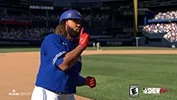|
|
What Playing Madden Teaches Us About Football — and What It Doesn’t
Nearly everything I know about football I know from Madden. My first encounter with the game came in 1992 in David Rabinowitz’s basement. I was 12, living in a cable-free household, in a town where the Sunday CBS or NBC broadcasts were very limited. My main exposure to the N.F.L. was through my trading-card collection — I had fortuitously invested in football cards in 1989 and therefore had the rookie cards for Troy Aikman, Barry Sanders, Deion Sanders and the great Andre Rison. But because I did not see a lot of football, even those stars were mostly just names to me.
Before we discovered Madden, Rabinowitz and I mostly played Leisure Suit Larry, a semi-pornographic computer game in which you navigated a balding sleazebag wearing a large golden medallion through a series of innuendoes. When we realized that Larry would never lead us to any meaningful nudity, we moved on to John Madden Football ’92, named for the TV commentator and former coach. The game, which first appeared in 1988, quickly established itself as a video-game colossus, with annual editions whose releases became events. It didn’t take long for me, either, to get hooked on the potency that comes from controlling the movements of football players, even if they were animated. The game, which that year featured an ambulance that crashed onto the field whenever a player got injured, stitched together the players on my trading cards into a simple, playable version of what I saw on Sundays. One of my first Madden lessons was that if you handed the ball off to video-game Barry Sanders — at least that’s who I assumed No. 20 in the unnamed Detroit jersey was meant to be — and repeatedly pounded the spin button, tacklers bounced harmlessly off his blockish body. Whenever I watched the real Sanders get stuck in the backfield and encounter a stumbling defender, my thought was: Hit spin button!
It has been 24 years since Madden ’92, and since then I’ve watched hundreds of N.F.L. games and finished in the bottom half of an unbearable number of fantasy leagues. But my excitement about football remains rooted in the way that Madden brought the names on the playing cards to life. I don’t think it’s much different for millions of football fans who grew up with (and continue to devote lots of grown-up time to) Madden. We are now mostly in our late 20s and early 30s and might be the first generation that substituted video games for real life, however inadequately.
My understanding of the N.F.L. still resides somewhere in the rudimentary playbooks of Maddens past. If, for example, my opponent has the ball on his 1-yard line, Madden logic dictates that I line up my team in something called “Goal Line” and choose between “Blitz A,” “Blitz B” and “Blitz C.” Today, whenever I see an N.F.L. team backed up close to the end zone, I half-consciously assume the defensive coordinator is weighing the same three choices. Madden’s appeal, I believe, lies in the way that it has boiled down an overly complicated sport into a series of easy, but seemingly meaningful, options: You can pass over the middle or run off tackle or heave the ball 50 yards downfield to your generation’s Randy Moss. And because those decisions have led to results on our screens, we believe a seemingly similar set of choices in real football can be solved through simple-minded Madden logic. This is why so many angry men believe wholeheartedly that they could coach an N.F.L. team: They’ve done it! They have run successful two-minute drills in Madden.
“The biggest difference between Madden and the real thing is that in Madden, you are one person playing the game, as opposed to a head coach or coordinator or quarterback or receiver, who are all seeing different things and having to make individual decisions,” Chris B. Brown, the author of a couple of “Smart Football” books that are some of the most eye-opening primers on N.F.L. strategy, told me recently. “A football play is almost like ‘Rashomon,’ where everyone is trying to piece it together. In Madden, you’re omniscient and can think you’re in control of all of it.”
The best video games reduce complicated worlds into a single, relatable simulacrum. But Madden does more than that: It takes the entire ecosystem of the country’s most popular sport and empowers the gamer to believe that nobody else could control it better.
For the past decade, Madden has felt stuck in time. The graphics get slightly sharper year by year, mostly as a result of cutaway sequences that seem to exist only to show that the graphics can, in fact, get sharper. The defenses supposedly get smarter, but generally those are jargon updates in the manner of “zone blitz.” Yet the running game, in which a halfback can seem to teleport from behind the line to three yards downfield, still defies the laws of time and space. It still feels impossible to defend passes across the middle to fast tight ends.
Some of these unrealities are intentional. Every year, Madden’s development team talks to coaches, players and other insiders in an effort to simulate a more authentic N.F.L. experience on the gaming systems of fans at home. This research is considered and then compromises are made between the nuances of what happens on an N.F.L. field and the simplifications needed by video-game players. “We discuss the limits of how much can be processed quite often,” Anthony White, a Madden gameplay designer, told me. “There are times when we will bring a strategic concept to the table and argue that it’s happening in the real game and will decide that it’ll be too complicated to implement into Madden.”
Madden is about more than just Xs and Os. The average player also brings to the game a wide range of emotional attachments and performance expectations. If you’re a Patriots fan, for instance, you will expect every pass from Tom Brady to Rob Gronkowski to result in a field strewn with the dead bodies of all defenders who dared to interfere with the inevitable touchdown; a self-hating Cowboys fan will expect every hit on Tony Romo to be followed by a notification that Tony Romo will be out for the next four to 10 weeks.
The first thing I did after downloading this year’s version of Madden was play as the Cowboys so I could test-drive Ezekiel Elliott, the team’s hyped rookie running back. I wanted to figure out where to draft him in my upcoming fantasy football drafts. Then I switched to the Steelers and spent a blissful hour throwing long, floating bombs to their star wideout Antonio Brown. For the 25th straight year, I made a quiet, solemn oath that this would be the year I finally figured out how to play defense, a commitment I abandoned in short order, when I went back to my usual habit of calling “Cover 2” on every play and blitzing the quarterback with my middle linebacker, thereby destroying the integrity of the Cover 2. Old habits prevail.
Madden might provide an imperfect and, at times, infuriating education, one that emphasizes how a coach uses his timeouts rather than, say, how he motivates his players. But it also has a sanitizing and anesthetizing effect on how we experience N.F.L. games — a distancing that might be necessary if we want to continue to enjoy them. Those ambulances that drove onto the field in Madden ’92, knocking other players out of the way with comic brutality, were eventually scrubbed from the game. Gamers didn’t need to be confronted with more violence. In the mid-2000s, Madden made it impossible for its players to receive “head” injuries. This happened, in part, because the N.F.L. wanted the game’s maker, EA Sports, to make the change, but also because John Madden himself reportedly wanted to do so. More than anything, Madden has reinforced a comfortable remove between what we watch on screens and the savagery actually taking place on real fields.
It seems, then, that a large number of N.F.L. fans — especially those who care only marginally about play calling and simply judge coaches based on the foolhardy challenge flags they throw and the two-minute drills they botch — have been trapped in an uncanny valley of sorts. The accumulation of all the years of Madden has provided a safer, more manageable facsimile of what we watch on Sunday.
The broad public grasp of football strategy may never progress far beyond Madden’s limits, never mind approach omniscience. Madden and, of course, fantasy football have expanded to take up too much space. There may very well be a way, in the near future, for gamers to strap on an Oculus Rift Vikings helmet and in virtual-reality mode go through all the “Rashomon” perspectives of an N.F.L. play or decide to kneel or stand during the national anthem, but if it existed, I’m pretty sure I would just throw bomb after bomb to Randy Moss.
|
|











